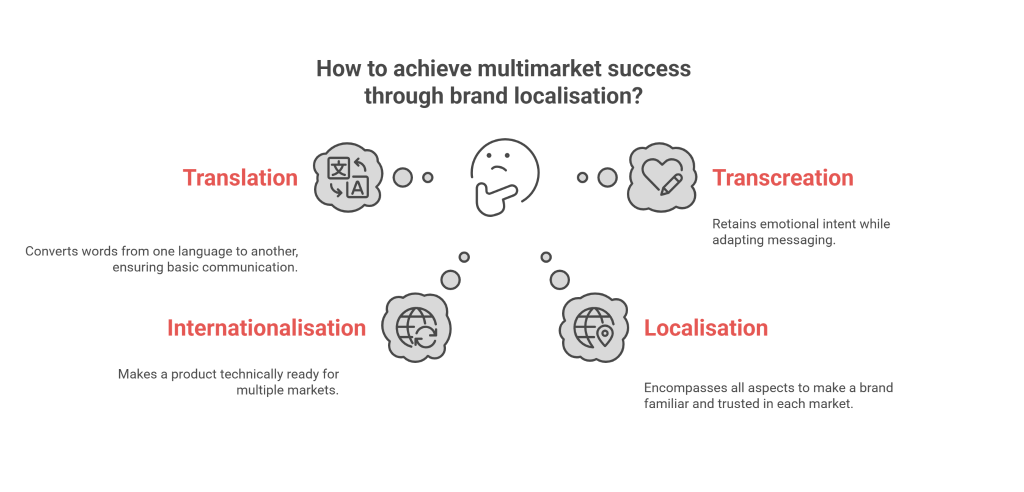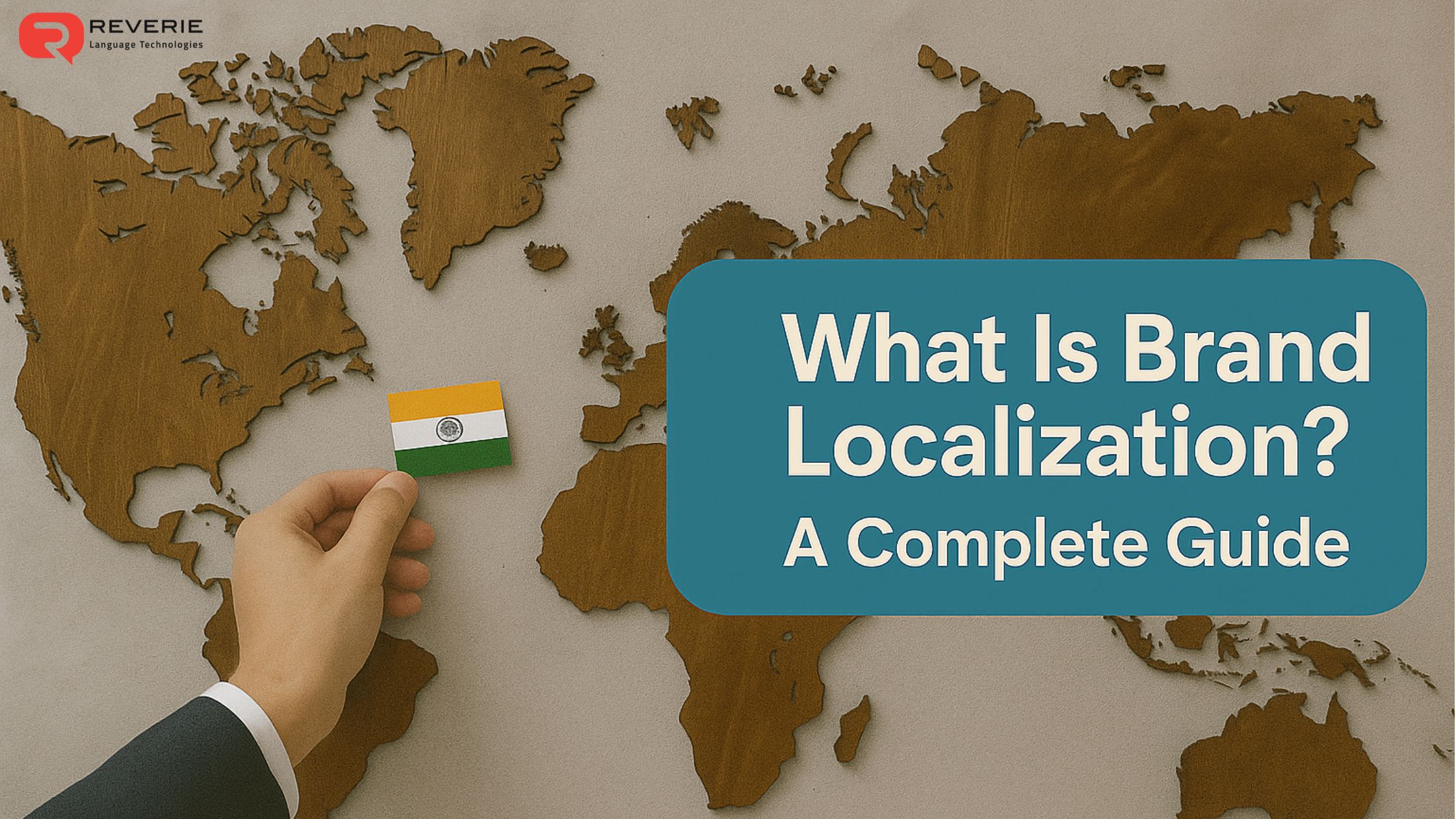Brand localisation has emerged as a critical approach for organisations entering new regions or scaling across multilingual markets. It focuses on aligning your brand’s message, visuals, and experience with the expectations and preferences of the people you’re serving in their language and in their cultural context.
As brands scale, those who invest in localisation succeed not because they look global, but because they feel local to every customer they reach. That’s where the difference lies.
Let’s explore how brands can create global footprints without losing their local soul.
Defining Brand Localisation the Right Way for Multimarket Success
Brand localisation refers to the process of adapting your brand’s presence, not just your product or content, to suit the language, culture, behaviours, and expectations of a specific regional audience. This goes far beyond translating content. It involves modifying how the brand is expressed visually, emotionally, and experientially in every market it touches.
This concept is often mistaken for translation or internationalisation, which are only fragments of a complete localisation framework:
- Translation converts words from one language to another.
- Transcreation ensures messaging retains its emotional intent, even if wording changes.
- Internationalisation makes a product technically ready for multiple markets (think: date formats, currency).
- Localisation, however, is the full package. It encompasses how your brand sounds, looks, and feels to someone living in Tokyo, Delhi, or Colombo, making your brand instinctively familiar and trusted in each place.

Take visual identity—McDonald’s uses green instead of red in Europe to reflect environmental consciousness. | Tone and voice? Netflix tweaks its copy for humour or seriousness depending on cultural expectations. | Even UX elements like icons or colour palettes require cultural attunement. |
Localisation preserves your global brand’s DNA but adapts the delivery in a way that resonates. In doing so, it prevents tone-deaf outreach and builds a genuine connection with the people your brand hopes to serve.
Winning Hearts in New Markets Starts with Deep Localisation Research
Before launching in any new geography, empathy must lead the strategy. You can’t localise what you don’t deeply understand. Market research is the backbone of effective localisation, and not the kind that stops at demographic stats. We are talking about language nuance, emotional triggers, buying behaviours, visual preferences, and social values.
According to a survey, 73% of shoppers prefer to buy products presented in their own language, and 40% won’t even consider buying if that’s not the case. The message is clear: if you’re not speaking their language culturally and literally, you’re not speaking to them at all.
Here’s what effective localisation research looks like:
- Quantitative: Surveys, digital analytics, A/B testing across geographies
- Qualitative: Focus groups, one-on-one interviews, ethnographic studies
- Cultural mapping: Understanding family values, work ethic, social customs, humor, and even sensitivities
For instance, Spotify didn’t just translate its interface when entering the Indian market. It launched with curated regional playlists in over 12 Indian languages, integrated voice search in local dialects.
Balancing Brand Consistency and Local Relevance Without Losing Identity
Every market adds a new lens through which people experience your brand. While consistency is important, relevance determines whether audiences will relate to your message or scroll past it.
To succeed across regions, brands need to preserve their core brand identity while adapting their expression at the edges.
Here’s how successful brands approach the balance:
Brand Component | What Stays Consistent | What Gets Localised |
Visual Identity | Logo, font family, layout structure | Colours, symbols, model imagery based on cultural associations |
Brand Values | Core mission, purpose, ethics | Expression of values (e.g., sustainability shown via local campaigns) |
Messaging & Tone | Personality (e.g. playful, bold, humble) | Local idioms, humour, call-to-action framing |
UI/UX Design | Site structure, product hierarchy | Navigation flow, reading order, layout spacing for local scripts |
Campaign Messaging | Brand themes, campaign logic | Taglines, seasonal relevance, calls to action |
Examples of Brands That Nailed Localisation
Here are some brands that maintained local relevancy without losing the core messaging:
- Zomato: When users open the app in different Indian states, they’re greeted with regional flavours — not just in cuisine, but in content. Push notifications are often in local languages and aligned with local festivals or weather, e.g., “It’s raining in Kolkata, time for some hot momo!” This subtle but strategic content design makes the experience feel personal.
- Flipkart: Beyond offering regional language interfaces, it integrates cultural moments deeply into its marketing calendar. From offering app interfaces in major Indian languages to adjusting banner creatives for Onam or Ugadi, the experience feels familiar, not foreign. Product recommendations also reflect hyperlocal seasonality, ensuring relevance at every scroll.
- Zepto: Zepto applies brand localisation through real-time, contextual content that aligns with regional behaviours. App banners, push notifications, and category naming adapt to local festivals, weather, and city-specific routines. For instance, in Bengaluru, its copy shifts tone and timing around local work routines and climate.
Building a Brand Localisation Strategy That Delivers in Every Language and Culture
A successful localisation strategy begins with the mindset that every market is uniquely human, not just another revenue stream. When you lead with this approach, your brand becomes more than global, it becomes local everywhere it matters.
The following are the essential building blocks for a high-impact brand localisation strategy:
- Set Measurable Goals for Market Expansion
Define what localisation should accomplish — market penetration, increased LTV, or improved engagement. Quantify goals such as regional conversion rates, bounce rates on localised pages, or uplift in multilingual customer support success.
- Do the Cultural Homework
Run both qualitative and quantitative research to understand not just what people buy, but how they think, speak, and emotionally engage. Invest in behavioural data, user testing with locals, cultural immersion studies, and audits of competitors operating in those markets.
- Develop Adaptive Brand Guidelines
Create region-specific localisation playbooks that provide flexibility within guardrails. Document tone variations, color palettes, image sourcing preferences, and even platform-specific behaviours by region.
- Build a Content Ecosystem That Supports Localisation
From marketing assets to UI copy and customer service scripts, structure your content in modular formats that make localisation faster and more consistent. Leverage translation memory and transcreation guidelines to scale up content efficiently.
- Use the Right Technology Stack
Automation reduces turnaround times and improves accuracy. Use tools like Reverie’s Anuvadak to automate and manage multilingual content efficiently, reduce manual effort, and maintain contextual accuracy across regional sites.
- Pilot, Test, and Iterate Before Going Wide
Start with 1-2 high-opportunity regions. Localise, test, measure, and refine before expanding the model to additional territories. Prioritise feedback loops with local teams and users.
- Evaluate and Evolve Over Time
Localisation isn’t static. Markets shift, languages evolve, and consumer preferences change. Build systems that collect performance data, user feedback, and competitor insights to continuously improve your localisation approach.
Avoid These Brand Localisation Errors When Expanding to New Markets
Missteps in localisation are often more expensive than delayed market entry. Even big brands have stumbled in their localisation journeys, but these stumbles offer valuable lessons.
Here are common mistakes brands must avoid:
- Skipping Cultural Sensitivity Checks
Brands like HSBC have faced costly consequences from mismatched slogans that carried unintended meanings. Its “Assume Nothing” campaign had to be rebranded globally when it was misinterpreted as “Do Nothing” in several regions.
- Over-relying on Literal Translation
Word-for-word translation can strip a message of its meaning — or worse, distort it entirely. A well-known case is KFC’s entry into China, where its slogan “Finger-lickin’ good” was initially translated as “Eat your fingers off.” The literal rendering missed the idiomatic nature of the phrase, resulting in confusion and an unappetising message.
- Inconsistent Brand Voice Across Regions
Without centralised control and local alignment, your tone can feel robotic in one market and overly casual in another. Define tone guides for each market with guardrails.
- Forgetting UI and UX Adaptation
Different markets read differently (LTR vs RTL), engage differently (scrolling habits, visual density), and respond to different layout aesthetics. Ignoring this alienates users immediately.
Powered by Reverie: How Anuvadak Transforms Localisation in India
Localisation can be time-consuming, technically complex, and resource-intensive, particularly when managing content across multiple Indian languages and dynamic digital touchpoints. For organisations targeting India’s multilingual market, achieving scale without compromising speed or content quality demands a smarter, automated solution.
Below are the ways Anuvadak is helping brands simplify and accelerate their localisation journey:
- Fast and Reliable Translation at Scale
Anuvadak uses an Indian language–specific neural machine translation engine, ensuring that localisation isn’t just accurate, but culturally appropriate. Content from the original English site is instantly translated and updated across multilingual versions, streamlining go-to-market efforts without delays.
- CMS-Agnostic Integration
Anuvadak is compatible with all major CMS platforms and web stacks. Regardless of your backend infrastructure, it plugs in easily, allowing marketing teams to localise content without relying on IT teams for heavy integration or development work.
- Multilingual Sub-Domain Management
Anuvadak automates the creation and management of language-specific subdomains, helping brands serve localised web content under structured URLs (e.g., hi.brand.com for Hindi, ta.brand.com for Tamil). This also improves SEO performance in regional markets.
- Zero Downtime for Ongoing Content Updates
Anuvadak auto-detects new content added to your English site and instantly queues it for translation, keeping all multilingual versions current without manual effort or site disruption.
It also supports real-time app localization via OTA (over-the-air) updates, allowing businesses to update in-app text like banners, buttons, and alerts in multiple languages without requiring a full app release. This ensures timely, region-specific updates that align with events, campaigns, or cultural moments.
Brand Localisation is the Future of Customer-First Growth Strategy
Every new market brings new expectations, and brands that choose to listen, adapt, and respond in the local language are the ones that thrive. Localisation isn’t just about translating what you say. It’s about reshaping how you’re understood. And that distinction is where lasting impact is made.
When a customer lands on your platform and instantly feels seen, because the language, tone, visuals, and references feel familiar, the conversation changes. What was once a global message becomes a local experience. That’s not a marketing tactic. That’s trust, built in real time.
Anuvadak makes it easier for teams to take their content into multiple languages quickly, accurately, and without the usual complexity. It helps brands stay relevant across markets while keeping everything consistent and easy to manage.If your business is ready to connect with India’s next billion users in their own language, now is the time to act. Book a free demo and see how Reverie can transform your brand localisation approach.
Faqs
What is brand localisation?
Brand localisation adapts your messaging, visual identity, content, and digital experiences to reflect the language, cultural nuances, and behavioural expectations of specific markets.
What are the core components of a successful brand localisation strategy?
A strong localisation strategy includes audience research, cultural adaptation, visual and content alignment, consistent brand governance, and scalable tech infrastructure.
How do leading brands maintain consistency while localising content?
They use structured brand guidelines combined with localisation platforms that allow controlled adaptation. Tools like Anuvadak enable local teams to align with brand voice while tailoring messaging to regional relevance.
What ROI can brands expect from localisation?
Localisation directly influences engagement, trust, and conversion. Brands that localise strategically see stronger customer retention and market penetration
What challenges do brands face when scaling localisation?
Challenges include maintaining brand consistency, managing decentralised teams, avoiding cultural missteps, and streamlining workflows across languages. Reverie’s Anuvadak helps mitigate these by automating translation flows and simplifying multilingual domain management.




